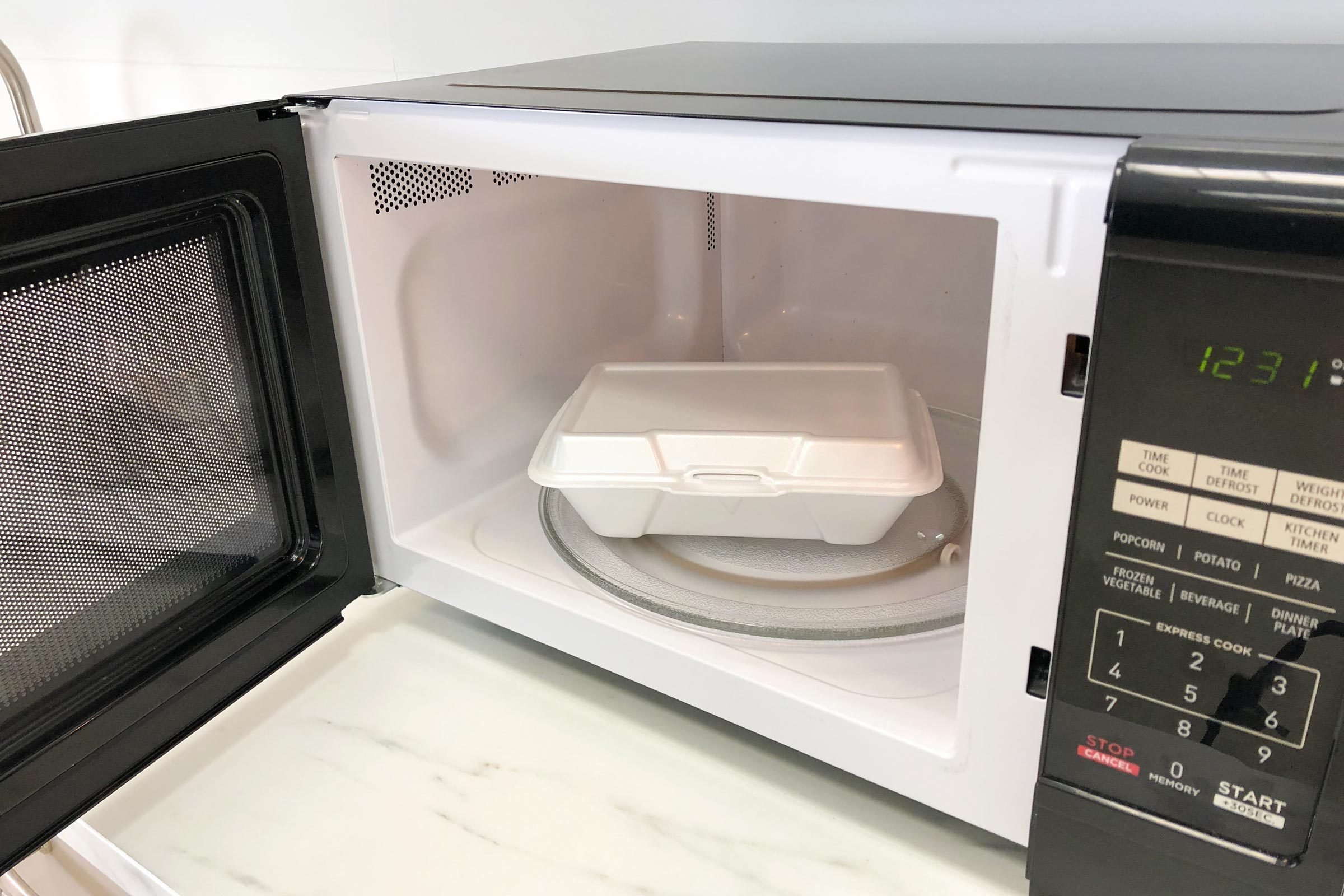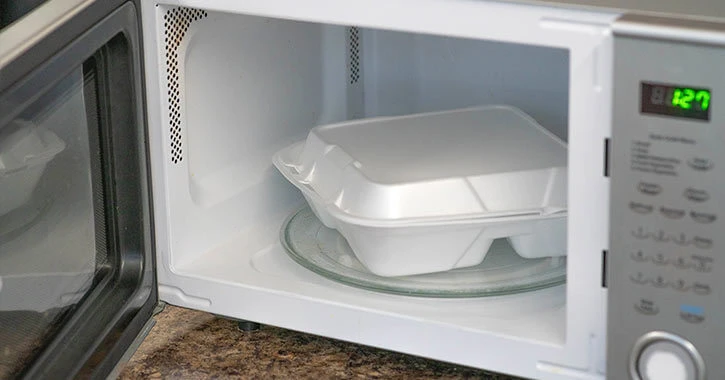No, you should not microwave Styrofoam. It can release harmful chemicals.
Table of Contents
ToggleMany people use Styrofoam containers for takeout or leftovers. But is it safe to heat them in the microwave? Microwaving Styrofoam can cause it to break down, potentially releasing toxic substances into your food. This is a concern for health and safety.
In this blog post, we’ll explore why microwaving Styrofoam is risky. We’ll also look at safer alternatives for heating your food. Understanding these risks and options will help you make better choices in your kitchen. Keep reading to learn more about the dangers of microwaving Styrofoam and how to avoid them.
Introduction To Styrofoam
Styrofoam is a common material in everyday life. Many people use it daily, often without much thought. It is lightweight and versatile, making it popular for various uses. But, what exactly is Styrofoam? And what are its common applications?
What Is Styrofoam?
Styrofoam is a type of plastic. It is made from polystyrene. This material is expanded and molded into shapes. It is known for being lightweight. It also has good insulation properties. People often confuse it with other types of foam. But, Styrofoam has specific characteristics. It is often used in packaging and building materials.
Common Uses Of Styrofoam
Styrofoam has many uses. It is popular in packaging. It protects fragile items during shipping. It is also used in food containers. Coffee cups, takeout boxes, and plates are common examples. In construction, Styrofoam is used for insulation. It helps keep buildings warm in winter and cool in summer. It is also used in arts and crafts. Sculptors and hobbyists use Styrofoam for projects. Its versatility makes it a valuable material in many industries.

Credit: www.instagram.com
Microwaving Basics
Using a microwave is convenient for heating food quickly. But not all materials are safe for microwave use. Understanding what you can and cannot microwave is important for safety and food quality.
How Microwaves Work
Microwaves use electromagnetic waves to heat food. These waves cause water molecules in food to vibrate. The vibration produces heat, which cooks the food.
This process is quick because microwaves penetrate the food. They heat from the inside out. This is different from traditional ovens, which heat from the outside in.
Materials Safe For Microwaves
Many materials are safe to use in the microwave. Glass, ceramic, and microwave-safe plastics are good options. These materials allow microwaves to pass through them without getting hot.
It is important to use containers labeled “microwave-safe.” This ensures they can handle the heat and will not release harmful chemicals. Avoid using metal, as it can cause sparks and fires.
Styrofoam And Heat
Styrofoam, a common material for food containers, raises questions about its safety in microwaves. Understanding how Styrofoam reacts to heat is crucial for making informed decisions. Let’s dive into the science behind it.
Heat Resistance Of Styrofoam
Styrofoam can handle temperatures up to 200°F. Beyond this, it starts to soften and lose its shape. Microwaves can easily reach higher temperatures, making Styrofoam less reliable. This material is not designed to withstand intense heat.
Chemical Reactions With Heat
When heated, Styrofoam can release harmful chemicals. One of these chemicals is styrene, which can leach into food. These chemicals pose health risks. Heating Styrofoam in a microwave increases this risk.
To stay safe, use microwave-safe containers. Always check labels before microwaving any material. Protect your health by avoiding Styrofoam in the microwave.

Credit: www.tasteofhome.com
Dangers Of Microwaving Styrofoam
Microwaving Styrofoam poses several dangers that many people might not be aware of. It can lead to serious health risks and even fire hazards. Understanding these dangers can help you make safer choices in your kitchen.
Health Risks
Heating Styrofoam in the microwave can release harmful chemicals. Styrene, a component of Styrofoam, can leach into your food. This chemical is linked to cancer and other health issues. Consuming food contaminated with these chemicals can be harmful.
Microwaved Styrofoam can also break down, leaving tiny particles in your food. Ingesting these particles can cause digestive problems. Long-term exposure to Styrofoam chemicals can have serious health effects.
Fire Hazards
Styrofoam is not designed to withstand high temperatures. Microwaving it can cause it to melt. This melting can lead to a fire in your microwave. Styrofoam can also ignite if it gets too hot. A fire in your microwave can cause damage to your kitchen and home.
Using Styrofoam in the microwave can create a dangerous situation. It’s best to use microwave-safe containers to avoid these risks. Be cautious and choose safe options for heating your food.
Types Of Styrofoam
Styrofoam, also known as polystyrene, is a popular material used for food containers and packaging. But not all types of Styrofoam are created equal. Some are safe for microwaving, while others are not. Knowing the difference can help you avoid health risks and potential damage to your microwave.
Microwave-safe Styrofoam
Some types of Styrofoam are designed to be microwave-safe. These containers are labeled as microwave-safe. They are made with materials that can withstand heat without melting or leaching chemicals. Always check for a microwave-safe label on the container.
| Microwave-Safe Styrofoam | Properties |
|---|---|
| Food Containers | Designed for reheating food |
| Cups | Suitable for hot beverages |
Non-microwave-safe Styrofoam
Non-microwave-safe Styrofoam can release harmful chemicals when heated. These containers are not made to handle high temperatures. Using them in the microwave can cause the material to melt and contaminate your food. Avoid microwaving any Styrofoam that does not have a microwave-safe label.
- Takeout boxes
- Packaging materials
- Disposable plates
In summary, always check the label on your Styrofoam containers. Ensure they are microwave-safe before using them in the microwave. This helps you avoid potential health risks and keeps your microwave in good condition.
Alternatives To Styrofoam
Microwaving Styrofoam can be risky. It can release harmful chemicals. So, it’s better to use alternatives. There are many safe and eco-friendly options available.
Microwave-safe Containers
Glass containers are a safe choice. They don’t leach chemicals. They are also durable and reusable. Ceramic containers are another good option. They heat food evenly and are easy to clean. Some plastics are microwave-safe too. Look for containers labeled “microwave-safe”. These are designed to handle heat without melting.
Eco-friendly Options
Bamboo containers are a great eco-friendly choice. They are biodegradable and free from harmful chemicals. Silicone containers are another green option. They are flexible, durable, and safe for microwaving. Stainless steel containers can be used, but not in the microwave. They are perfect for storing and transporting food.
Using these alternatives can be better for your health. It can also help the environment. So, next time you heat food, choose a safer option.
Proper Use And Disposal
Styrofoam is common in food packaging and disposable containers. It’s lightweight and insulates well, making it popular. But it’s important to use and dispose of it safely. Misuse can lead to health risks and environmental harm.
Safe Handling Tips
When microwaving Styrofoam, ensure it is microwave-safe. Check the container for a microwave-safe label. Without this label, do not heat it in the microwave. High temperatures can cause Styrofoam to melt or release harmful chemicals. Use glass or ceramic containers for heating food. They are safer and do not leach chemicals.
Do not overheat food in Styrofoam containers. Heat food for short intervals and check frequently. This reduces the risk of melting. Avoid reheating fatty or oily foods in Styrofoam. These foods can cause the container to break down faster.
Recycling And Disposal
Styrofoam is not easy to recycle. Many curbside recycling programs do not accept it. Check with your local recycling center for Styrofoam recycling options. Some centers accept clean, dry Styrofoam for recycling. This includes packaging materials and food containers.
Proper disposal of Styrofoam is crucial. Do not burn Styrofoam. Burning releases harmful chemicals into the air. Bag Styrofoam before placing it in the trash. This prevents it from breaking apart and creating litter. If possible, reduce your use of Styrofoam. Choose reusable or biodegradable alternatives instead.

Credit: www.healthline.com
Frequently Asked Questions
Can You Microwave Styrofoam Safely?
No, it is not safe to microwave styrofoam. It can release harmful chemicals. Always check the label for microwave safety.
What Happens If You Microwave Styrofoam?
Microwaving styrofoam can cause it to melt or release toxic chemicals. This can contaminate your food.
Are There Microwave-safe Styrofoam Options?
Yes, some styrofoam containers are microwave-safe. Always look for a microwave-safe label before use.
How To Identify Microwave-safe Styrofoam?
Check for a microwave-safe symbol on the container. If unsure, avoid microwaving it to be safe.
Conclusion
Microwaving Styrofoam can be risky. Some types release harmful chemicals. Always check the label. Look for microwave-safe symbols. If unsure, use a microwave-safe container. Safety comes first in the kitchen. Avoid potential health hazards. Choose glass or ceramic instead. Small steps can protect you and your family.
Stay informed and microwave wisely.
{ “@context”: “https://schema.org”, “@type”: “FAQPage”, “mainEntity”: [ { “@type”: “Question”, “name”: “Can you microwave styrofoam safely?”, “acceptedAnswer”: { “@type”: “Answer”, “text”: “No, it is not safe to microwave styrofoam. It can release harmful chemicals. Always check the label for microwave safety.” } } , { “@type”: “Question”, “name”: “What happens if you microwave styrofoam?”, “acceptedAnswer”: { “@type”: “Answer”, “text”: “Microwaving styrofoam can cause it to melt or release toxic chemicals. This can contaminate your food.” } } , { “@type”: “Question”, “name”: “Are there microwave-safe styrofoam options?”, “acceptedAnswer”: { “@type”: “Answer”, “text”: “Yes, some styrofoam containers are microwave-safe. Always look for a microwave-safe label before use.” } } , { “@type”: “Question”, “name”: “How to identify microwave-safe styrofoam?”, “acceptedAnswer”: { “@type”: “Answer”, “text”: “Check for a microwave-safe symbol on the container. If unsure, avoid microwaving it to be safe.” } } ] }

